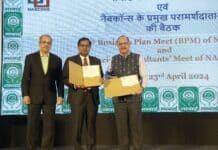By Rajashekhara V Maiya, VP and Global Head – Business Consulting, Infosys Finacle
The world’s largest democracy is leading democratisation in other areas as well. The most notable in recent times is instant digital payments on the unified payments interface (UPI), which is now accessible to anyone in India with a mobile phone and is also making its way to other countries. So, how has India, which is still battling basic issues like poverty and illiteracy, achieved unprecedented success in opening universal access to not just digital payments but also social security transfers, capital markets, and credentials data management, to name a few?

Not magic, but a model
India’s process of democratisation begins with the creation of a product (for example, Aadhaar), a platform, such as the India Stack, or a protocol, such as UPI. The open network for digital commerce (ONDC) or the open credit enablement network (OCEN) are examples of such democratisations. However, building something unique or powerful does not guarantee success at scale unless it is standardised, industrialised, and democratised.
And this hyper scaling isn’t new to the country: down the ages, India has demonstrated its ability to adapt this model. For example, down the ages, as yoga evolved, it was documented and structured by Patanjali i.e., standardised. It was industrialised by wide-spread adoption across the country and was followed by the democratisation of the practice by sharing it with the whole world.
Today, the country continues its tradition of dedicating enablers of public good for the world’s benefit by democratising various digital public good infrastructure (PGI).
Making the right choices
After deliberating its options for infrastructure and innovation, the country chose a public infrastructure but with the private innovation model, which now underlies UPI digital payments, ONDC, OCEN, and other initiatives. India then leveraged a digital tech stack and APIs to standardise these protocols before applying them at a scale within India en route to democratising access for the rest of the world.
Consequently, the country has managed to overcome many of the problems that even developed economies struggle with, such as the absence of a digital fast payments system (even today, 133 countries don’t have one) or lack of digital identity and formal banking access (impacting 4 billion and 2.5 billion people respectively globally).
In keeping with the Indian tradition of making public goods accessible to all, the Aadhaar unique identification number was made available to every resident in India, free of cost. Once the identity was democratised, it was used as a platform to democratise other services, such as digital real-time payments (India accounts for 46 per cent of global transactions).
Another area to benefit significantly was direct benefit transfers. During the pandemic, the U.S. banking system grappled with the problem of issuing 90 million relief checks. But thanks to India’s democratic public good infrastructure (including Aadhaar), India was able to disburse food supplies to 800 million, and monetary support worth $10 billion to 420 million people.
But this progress was not achieved overnight. In 2013-14, fewer than 108 million beneficiaries received direct transfers. As the process moved from standardisation to industrialization to democratisation over ten years, the number of beneficiaries jumped 8.5 times to 920 million, and the amount disbursed grew 34 times from ₹73 billion to ₹2,500 billion.
Building a truly democratic public infrastructure
A notable feature is that India’s public good infrastructure is that it is truly democratic — accessible to everyone regardless of income, ethnicity, caste, and religious background. Today, offline and QR code-based UPI payments, which are agnostic of smartphone ownership, are growing fastest in rural India.
But in the spirit of true inclusivity, the nation has also introduced other initiatives to benefit middle and upper-income segments too: DigiLocker has democratised data management, and today, more than 137 million India citizens access their credentials and certifications, starting with birth certificates, on a single data management infrastructure. Gujarat International Finance Tec-City (GIFT City) is opening access to foreign capital to anyone with a need, capability, and business plan. Standardisation, industrialisation, and democratisation of India’s capital markets allow even the smallest investor to buy and sell gold, equity, and other securities digitally.
Riding on the success of the Jan Dhan Yojana, which opened 460 million bank accounts, 350 million of them in non-metro areas, India now plans to democratise insurance and, in a UPI-like fashion, build a unified health infrastructure.
Given its versatility, scalability, economy, and efficiency, there is no limit to how far this model can go.













